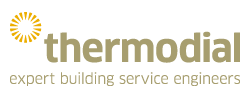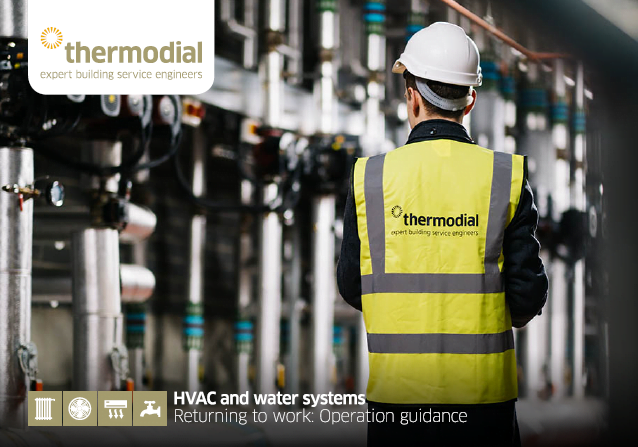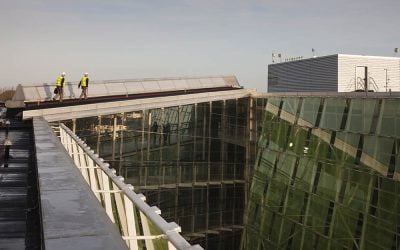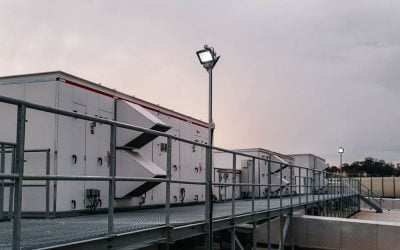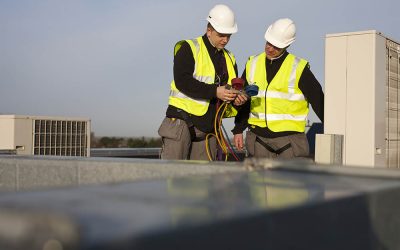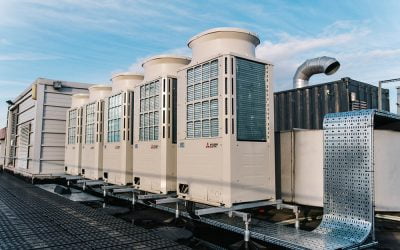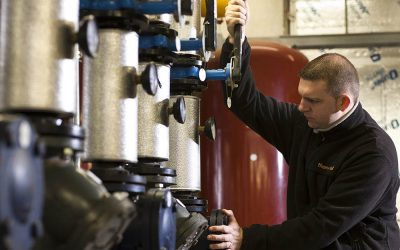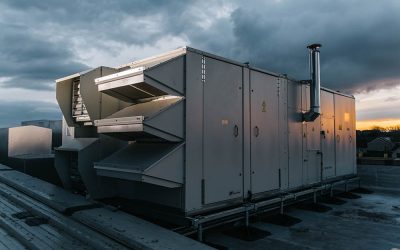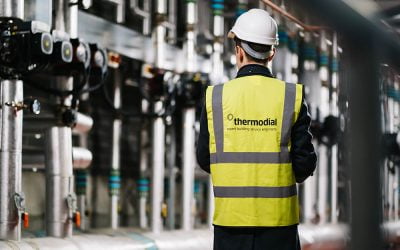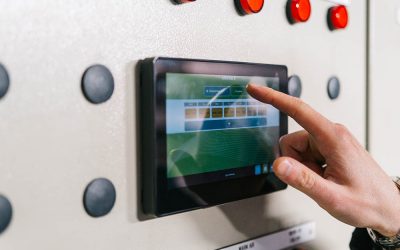Ventilation service and maintenance
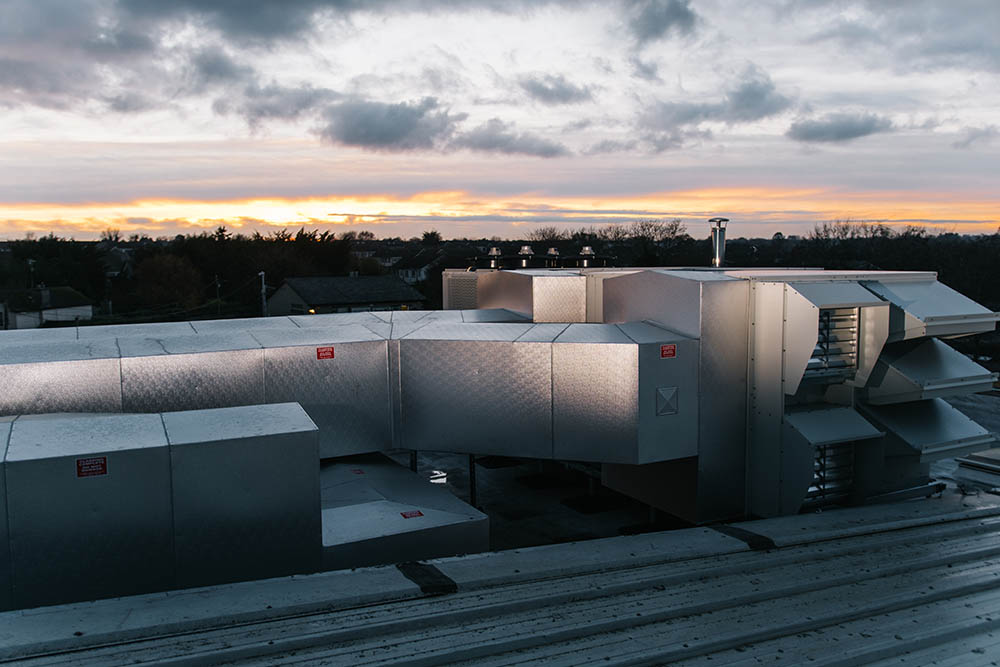
Ventilation service and maintenance consists of tests, checks, calibration and balancing of ventilation systems to confirm their correct and efficient operation. Only trained and competent service engineers should carry out service and maintenance work on ventilation systems, due to their complexity, for the health and welfare reasons and business critical importance.
Ventilation systems
Ventilation systems are generally broken into mechanical ventilation and natural ventilation.
Mechanical ventilation
Mechanical ventilation provides clean air inside a building through a ducting system, aided by mechanical means, such as disposable filters and fans.
Natural ventilation
Natural ventilation is the air which enters a building without any mechanical assistance – often through doors, windows and vents. Natural ventilation can be found in nearly every building, while mechanical ventilation is mainly found in buildings in a built-up area; buildings of high occupancy or where required in industrial settings.
Either one or a combination of both mechanical and natural ventilation might be required to satisfy indoor room air quality, depending on the room or building and its function.
Mechanical ventilation service and maintenance
Ventilation servicing is carried out in accordance with following requirements:
- The original equipment manufacturer’s (OEM) specification i.e. their recommendations.
- Your own business specific requirements.
- Specific environmental factors, such as the location of a building – a location in a built-up area could dictate more frequent servicing. Likewise, the purpose of the building dictates the frequency of servicing, i.e. a hospital, data centre or clean room setting would require more frequent servicing than a typical office or school.
- The advice from your maintenance provider considering ventilation rates/air changes per hour based on building occupancy and uses.
- Current health and safety regulations or guidelines, such as those concerning the safety of staff in public health emergencies such as the Coronavirus (COVID-19) pandemic. A risk assessment should be drawn up to consider safety factors.
Servicing should take place between two and four times per year in a commercial building – depending on specifications, environmental factors, advice, health guidelines and risk assessments.
The process of servicing a mechanical ventilation system is known as planned preventative maintenance (PPM).
Therefore, PPM is a risk averse measure, ensuring uptime of operation-critical systems in accordance with a breadth of requirements.
Mechanical ventilation PPM
Mechanical ventilation service checks include: verification of efficient operation; health and safety inspections; examination of critical components; examination for wear and tear signs; appropriate discharges; inspection of electrical connections and analysis of operation parameters, such as, temperatures, pressures, noises and vibrations.
PPM seeks to service ventilation as a part of the overall heating, ventilation and air conditioning (HVAC) system. This ensures that ventilation systems are acting in harmony and not competing against heating and air conditioning systems, which can sometimes occur.
Mechanical ventilation servicing can take place on a variety of different units, such as: air handling units (AHU); heat recovery ventilation (HRV) units; fan coil units, variable air volume (VAV) units and ventilation fans. Depending on the system, servicing will also have to take place on other connected installations within the system, such as, boilers, chillers and the building energy management system (BEMS). These ancillary systems may feed and control mechanical ventilation systems.
Mechanical ventilation service in buildings
Ventilation is important in a building because it creates an airflow, introducing fresh air into a building and helping to remove bad odours and smells. When fresh air enters a building, it is filtered through disposable filters and then conditioned. These filters help to trap dust and dirt, microbiological particles and contaminates. Then after the air is conditioned to temperature, it enters the desired local space to refreshing the room’s air and help dilute and remove any airborne pollutants. Stale air is removed via a grille, creating an airflow in the local space. This reduces the risk of occupants getting sick or becoming infected by airborne viruses, such as COVID-19. However, in some ventilation systems, the stale air is recycled and mixed with the incoming fresh air, saving on energy costs, but incurring a health penalty for building occupants.
Damp and mould can appear within buildings. Mechanical ventilation does not remove damp or kill mould, but it is part of the solution to its prevention and removal. Damp is usually caused by contaminates in the air which settles on surfaces, due to a lack of ventilation.
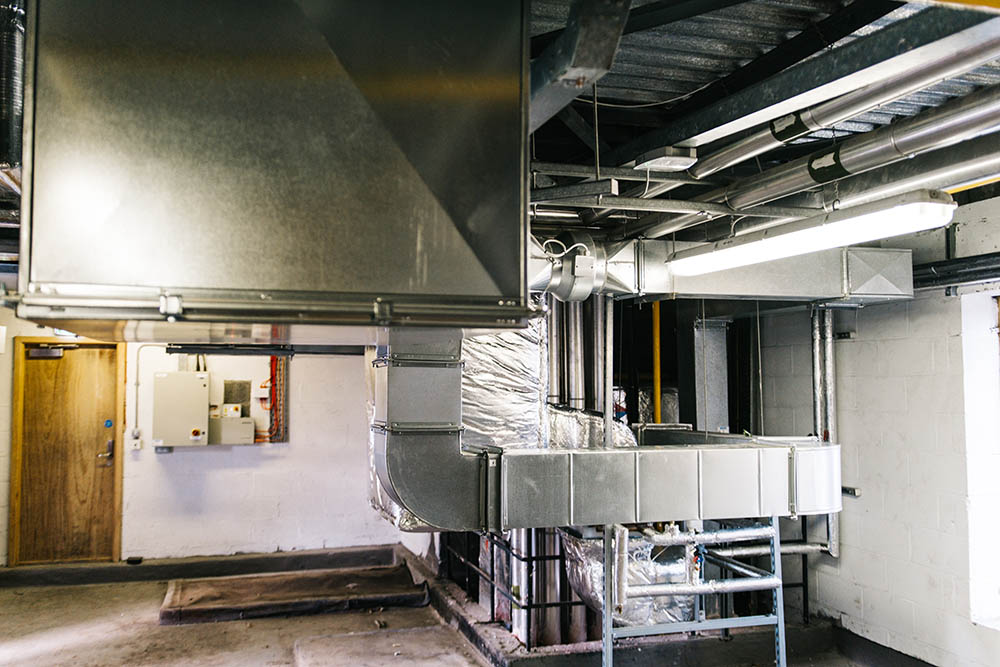
Ventilation ducting
A ducting system – also called ductwork – delivers and removes air throughout a building. It is an essential part of a mechanical ventilation system. The ductwork system forms a series connected passages solely for air flow, either above the ceiling or below the floor, to deliver heated, cooled or humidified air from a central air handling unit to the relevant room or space. In a smaller buildings where an air handling unit may not be present, duct systems deliver outside air to local air conditioning units, local heat recovery ventilation units, variable air volume units and close to fan coil units – without being connected.
When ventilation is required
- A mechanical ventilation system in a building exists for two reasons:
Oxygenate, refresh and maintain clean air quality – essential for human health and survival. - Extraction of fumes, dust, odours or vapours – from an industrial or process environment, i.e. where a manufacturing process is taking place.
That considered, the importance of adequate ventilation cannot be understated, particularly with the prevalence of an airborne virus, such as COVID-19.
Types of mechanical ventilation systems
There are several different types of mechanical ventilation systems, such as:
- Air handling unit (AHU) ventilation
- Mechanical heat recovery ventilation (MHRV) or heat recovery ventilation (HRV)
- HRV with rotary heat exchanger or thermal wheel
- HRV with fixed plate heat exchanger
- HRV with run-around coil
- Fan coil unit ventilation
- Variable air volume (VAV) unit ventilation
- Ventilation fan

Air handling unit (AHU) ventilation
An air handling unit or AHU is used to regulate and distribute air within a building, via a network of ductwork. It forms part of the building’s wider heating, ventilation and air conditioning (HVAC) system.
AHUs are generally found in medium to large commercial buildings and are located within basement areas, rooftops or in some cases, beneath floors or above ceilings.
The aim of the AHU is to provide a healthy and comfortable indoor environment by filtering and conditioning – through heating, cooling or humidification – the incoming air and extracting stale air, via the ducting system.
AHUs come in various shapes and sizes and can perform various functions. An AHU can contain a mix of other services, such as, gas burners, heating coils or cooling coils – heating and cooling the air respectively. They can also be connected to external boilers, chillers or ventilation units, providing similar heating, cooling and ventilation services.
Some AHUs are also designed to provide full fresh air to a building – supplying 100% outside air, without mixing with re-circulated indoor air – while others may have a heat recovery unit contained within to save energy.
Before the air is conditioned, however, it must be filtered through (primary) panel and (secondary) bag filters, to protect the building occupants from microbiological material and the mechanical system components from damage. Air is pulled through the filters by large fans.
The humidity controls in an AHU can be crucial to buildings containing document archival stores or those with data centre or computer room equipment – where maintaining a stable environment for the valuable materials and equipment is critical. Some level of cooling is required in these areas to protect the contents. Humidity controls are then further required – to avoid condensation and thus damage – as the cooling process adds moisture to the air. A de-humidifier extracts moisture from the air and protects the stored contents and equipment from condensation – a by-product of cooling.
Additional energy saving devices can also be fitted or connected to some AHUs, cleverly re-using the energy initially spent to heat, cool or humidify the incoming air. These devices are known as heat recovery ventilation (HRV) units.
Instead of extracting all stale (exhaust) air from a room or building, a HRV unit recovers some of the energy from that stale air and uses it to condition incoming fresh (supply) air. This is a popular cost saving component, particularly in larger buildings where energy costs are considerable. Heat recovery ventilation and methods of heat recovery are further examined below.
AHU ventilation service checks
Ventilation service and maintenance of air handling units include: inspection of supply fan drive pulleys; inspect fan belts; inspection of fan scroll; lubrication of bearings; testing of motor absorbed current; checking of overload pack; inspection of anti-vibration mountings for signs of deterioration; cleaning of air chambers and dampers; checking of all dampers and three-port valves for operation on control and frost protection cycle; checking of control set-points, checking space return and discharge temperatures and the checking of control sequence, dead zones and stability.
Checking of valve actuators; checking of valve shaft seals; inspection of the condition of internal and external casing, doors, doors hinges, locks and supports for corrosion or damage; checking over-heat limit device is operating and set up correctly; inspection of heating and cooling coils; inspection of the fitting of eliminator plates; checking of condensation trays and testing that they do not leak and that drains are not blocked; examination of condense traps; inspection of filter conditions; check-up of service history and filter manometers and bag filter beds to ensure seals around the filter frames and clips are in place are also included in PPM checks. Finally, any above normal or acceptable noise levels are investigated post service, along with any indications of mechanical abnormalities.
Heat recovery ventilation (HRV) or mechanical heat recovery ventilation (MHRV)
Mechanical heat recovery ventilation (MHRV) or heat recovery ventilation (HRV) reduces energy spend by thermal energy transfer in a specialised mechanical unit.
HRV works by extracting energy from stale air inside a room – which ordinarily would be exhausted out of the building – and transferring that energy to condition the incoming fresh air. Fully exhausting warm stale air from a room – which energy has already been used to condition – is wasteful of energy. Re-using that energy to condition the incoming fresh air is energy, environmental and cost efficient.
For these reasons, heat recovery is an increasingly used method of ventilation. Heat recovery units can be either located inside an air handling unit or as a standalone unit above a ceiling and connected into the building’s duct system.
The method of heat recovery ventilation installation can differ and these differences can have a great impact on the health and welfare of building occupants, particularly during public health emergencies.
HRV – rotary heat exchanger or thermal wheel
A rotary heat exchanger or thermal wheel is a slow turning wheel with a perforated or honeycomb-like centre which allows the transfer of energy between two adjacent airflows – incoming fresh (supply) and outgoing stale (exhaust). The material of the wheel allows for energy transfer by absorbing energy from warm exhaust air, then immediately releasing it to the supply side. The two air flows are kept separate, however, there will be some degree of leakage. This runs the risk of sending extracted airborne pollutants back into the ventilation system. However, if fans are in the recommended configuration and a purge sector is fitted to prevent cross-over of exhaust to supply air, rotary or thermal wheels could operate safely.
The purge or purging sector is an additional specially designed mount to the rotary/thermal wheel and is designed to virtually eliminate cross contamination of airflows. The purging sector works by utilising pressure differences between indoor and outdoor air to purge or clean the perforated honeycomb-like centre with clean air, while the physical purge mount blocks any stale air from passing through. The wheel then rotates into the fresh (supply) air and feeds the ducting system with appropriately conditioned air. The purge sector will cost more in energy spend, however, due to the increased air flow volume required to clean the perforated wheel.
It is prudent to have the rotary/thermal wheel and purging sector – inspected by a competent and experienced HVAC service engineer to prove their correct operation, without leakage. This is of particular staff safety importance during public health emergencies such as the Coronavirus (COVID-19) pandemic.
HRV – fixed plate heat exchanger
A fixed plate heat exchanger is the most common method employed in heat recovery. The process involves thin metal plates stacked closely together, allowing two separate airflows to pass through, adjacent to each other. The energy then passes via the plates – made up of materials such as aluminium which has a high thermal conductivity – from the outgoing stale (exhaust) to the incoming fresh (supply) airflow. A slight risk of leakage of potential airborne pollutants or microbiological contaminates also exist in fixed plate heat exchangers too.
HRV – run-around coil
A run-around coil is another common method of recovering heat, however, it does incur additional energy demands. The outgoing (exhaust) airflow is located separately to the incoming (supply) airflow, connected by a looped pipe containing fluid. This fluid extracts energy from the stale exhaust air and supplies it to the supply fresh air. The additional energy costs are owing to the pumps which operate to continually pass fluid around the pipe between the two separate sides. This method works similar to the fixed plate heat exchanger, without the possibility of airflows mixing or spilling over, thus, it is the least risky method of heat recovery when dealing with airborne pollutants or microbiological contaminates.
HRV with a summer bypass
Some heat recovery ventilation units are fitted with a summer bypass mode. This mode recovers the energy but bypasses the heating process when recovering waste heat. This is generally utilised during the summer where there is no requirement for further heating to be applied to the incoming air.
Heat recovery ventilation service checks
Ventilation service and maintenance of mechanical heat recovery units include: cleaning of air chambers and dampers; inspection of fan scroll; checking of overload pack; inspection of the supply fan; inspection of interior and damper seals; operation of dampers on control; inspection of motor connections for signs of stress, i.e. discoloration of terminals, lugs, cable cores and cable PVC; adjustments to control set-point and checking of other set-points. Finally, any above normal/acceptable noise levels are investigated post service.
Fan coil unit (FCU) ventilation
A fan coil unit (FCU) is designed to condition localised room air – either using re-circulated stale air only or a combined mixture of re-circulated stale air and fresh outside air. FCUs are generally located in a void area, either above the ceiling or beneath the floor. A mixture of fresh and stale air is only possible in the ceiling unit, due to its proximity to the ducting system and thus supply air from the AHU. Floor units cannot benefit from access to the ducting system; therefore, they are only capable of re-circulating stale air in a room or space.
In ceiling units, fresh air is blown into the FCU from the duct, leaving some space for re-circulated stale air to enter alongside, as the ducting and FCU are not directly connected. This mixture of air is first blown through a plastic filter and then it is conditioned. Floor units also filter the incoming air. Filtration keeps dust and dirt away from the inside of the unit, not only protecting the internal mechanisms from damage, but also aiding the unit’s energy performance – where parts are free to move and operate without obstruction.
Most FCUs will contain a heating and cooling coil past the filtration stage – supplying warm or chilled water from a boiler or chiller to heat or cool the incoming air. This air is then supplied to the room at the requested temperature of the connected local controller. FCUs can heat and cool by slightly different methods too. Heating may be provided electrically, while cooling may be provided from refrigerant gas in centralised air conditioning plant.
Fan coil unit ventilation service checks
Ventilation service and maintenance of fan coil units include: vacuum cleaning of filters; cleaning of fan scrolls for any impinging materials; vacuuming of intake grill, surrounding area and coil faces; checking of operation of low pressure hot water and chilled water four port valves; checking operation and calibration of control temperature sensors; checking operation of condense drains; cleaning discharge grille and surrounding ceiling tiles; checking fresh air intake surround and checking temperatures on heating and cooling cycle.
Finally, any above normal/acceptable noise levels are investigated post service, along with any indications of mechanical abnormalities.
Variable air volume (VAV) unit ventilation
Similar to fan coil units, VAV units are very common in offices, however, they benefit from greater energy efficiencies. VAV units provide conditioned, localised air in a room from the AHU, connected via the ducting system and controlled by a local controller.
However, the VAV unit or box, is more efficient due to its modulating control, which basically allows air into the unit and then the room, only when required by an air sensor. This sensor regulates – on demand – the volume of air entering into the unit off the main duct and then conditions it to a desired temperature. Not only does this variable supply of air save on energy, it also provides better comfort for room occupants, through closer control of heating and cooling services.
Variable air volume (VAV) unit ventilation service checks
Ventilation service and maintenance of VAV units include: inspection of piping connections and valves glands for signs of leakage; checking of test port blanks; checking the controller is stable and not hunting; adjustments to local control in heat and cooling modes in gradual increments; checking of the damper motor and three port valve motor drives; checking of bypass position; assessment of three port valve seats; checking of flexible duct connections for leakage and the calibration of controls as appropriate.
Ventilation fans
Ventilation fans are built to serve different purposes, therefore, they come in many different shapes and sizes. A building could contain any of, supply fans, extract fans, toilet fans, kitchen extract fans – and more besides.
The purpose of these fans is to direct airflow in a particular direction to or from a particular area.
Ventilation fan service checks
Service and maintenance of ventilation fans include: inspection of the fan impeller; lubrication of bearings; testing of motor absorbed current; checking of overload pack; inspection of anti-vibration mountings for signs of deterioration; checking the condition of external casings and supports for corrosion; inspection of motor connections for signs of stress, i.e. discoloration of terminals, lugs, cable cores and cable PVC; checking of the terminal box; inspection of the automatic damper mechanism; proof of automatic damper changes to the correct position; vacuuming of filters; inspection of fan belts; inspection of fan scroll; cleaning of air chambers and dampers; checking of all dampers and three-port valves for correct operation on control and frost protection cycle; adjustments to control set-point; checking of valve actuators and the valve shaft seals; inspection of electrical connections and wiring; monitoring safety or limit devices are in circuit and operating and checking the condition of internal and external casing, doors, doors hinges, locks and supports for corrosion or damage.
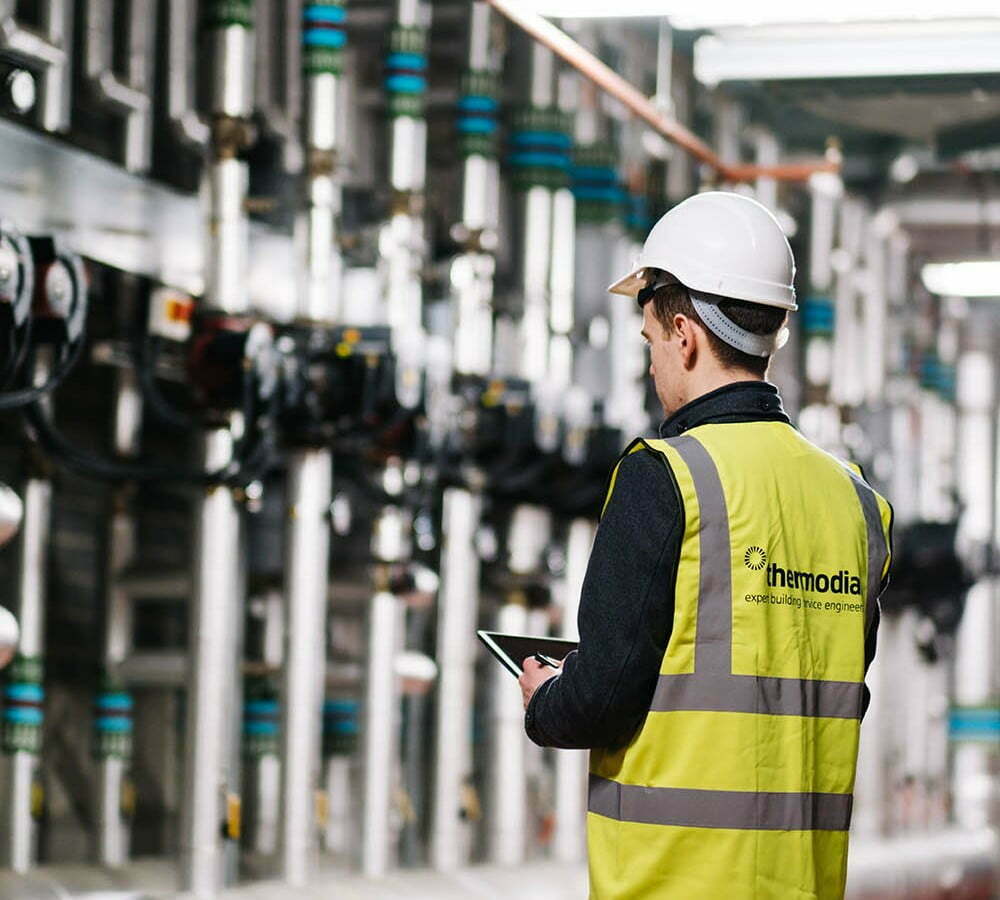
Completing mechanical ventilation service – all system types
To complete service visits, a record of the service visit should be logged on the service label in the plant room – specifying service actions, persons and dates – while a far more detailed record should be inputted into a computerised maintenance management system (CMMS).
This builds up a service history which aids future decision making on system upgrades and displays when and which parts have been replaced. It also provides a complete picture of historical ventilation performance levels.
As part of mechanical ventilation PPM, it is also prudent to maintain a stock of spare system parts on site. Particularly those critical to operation or ones that can be difficult to obtain at short notice. Having replacement critical system parts to hand helps to mitigate the risk of potential system downtime.
Ventilation rates/air changes per hour (ACH)
Ventilation rates signify the number of times the air volume in a room is changed, however, due to air mixing, this does not mean all of the original air is replaced. The ventilation rate is calculated and expressed in terms of air changes per hour (ACH) and it varies, depending on the size and function of the space you wish to ventilate.
There are general ventilation rates applicable to certain buildings, depending on room size and purpose. For example, classrooms, offices, retail shops, bedrooms, factories and data centres all have different recommended air change rates. Ventilation rates can range from two air changes per hour – oxygenating a room for survival – to one hundred per hour – extracting fumes from a room. These rates are calculated by a qualified engineer or a ventilation service provider using a psychrometric chart.

Control of mechanical ventilation systems
Building sensors and thermostats generally control room comfort to desired temperature and humidity levels for local occupants. Control is provided via wall mounted digital displays or dial room controllers, which call on the relevant heating, cooling or humidification service.
Central controls of ventilation systems are provided by building energy management systems (BEMS) and allow local controllers to operate within certain parameters. They maximise the comfort of occupants and minimise energy consumption. The BEMS also takes more factors into consideration than local controllers, such as the outside weather conditions or the aspect of the building, for example. A BEMS will allow for the well-balanced operation of the complete HVAC system, ensuring ventilation services are acting in harmony and not competing against heating and air conditioning systems.
Benefits to mechanical ventilation service
1. Improved reliability
Performing PPM of mechanical ventilation systems provides proof of efficient working order of systems, protecting your capital investment. It also identifies any malfunctioning or faulty system components that maybe in need of repair. This helps to ensure maximum uptime of the system, giving you peace-of-mind. It also provides the benefit fresher, cleaner air, enhanced comfort for occupants and more precise control for a business-critical process.
2. Staff and public health
Periodic PPM also supports a safe working environment through the regular inspection of the working condition of mechanical ventilation systems. This provides peace-of-mind of system operation worthiness. Service engineers can also advise on whether current system configurations are appropriate for existing and/or future use. The safety of staff cannot be overlooked in times of public health emergencies, such as the Coronavirus (COVID-19) pandemic.
Employers in Ireland are also required to perform maintenance and remedy breakdowns in compliance with article 6 of Statutory Instrument (S.I.) No. 299 of 2007 of Safety, Health and Welfare at Work (General Application) Regulations 2007:
if a forced ventilation system is used, it is maintained in working order and any breakdown is indicated by a control system if necessary for the safety and health of employees…
ventilation of enclosed places of work
3. Energy Efficiency
PPM seeks to optimise the energy efficiency of mechanical ventilation systems, harmonising their operations with other connected plant and equipment within the HVAC system. While the PPM checks will ensure systems are not operating inefficiently or wastefully. A well-balanced system operating to optimal levels can provide closer control of the work environment and energy savings – costing you less money to operate.
Implications of no mechanical ventilation service
1. Operations downtime
Mechanical ventilation systems may directly or indirectly feed into your production or business operation supply chain. Therefore, the care and attention of PPM is required. Without service and maintenance, business operations could incur unwanted downtime for repairs, costing you money and damaging to your brand’s reputation.
Further, any warranty claims to system manufacturers can be dependent upon evidence of periodic service records from competent providers.
2. Staff health and legal compliance
Sickness or increased complaints from staff can result from ventilation systems not operating within advised specifications for public health emergencies or as locally desired. This can have serious health and safety implications, particularly during the Coronavirus pandemic; it can lead to industrial relations issues; or at best, increased staff complaints due to uncomfortable conditions – be it too hot or too cold.
Moreover, employers have a duty to comply with workplace safety regulations set out by the Irish government – in this case, S.I. No. 299 of 2007 (article 6) – employers must ensure:
sufficient fresh air is provided in enclosed places of work… any deposit or dirt likely to create an immediate danger to the safety and health of employees by polluting the atmosphere is removed without delay.
ventilation of enclosed places of work
3. Energy waste
Mechanical ventilation installations by their very nature can be complex systems. This is due to the vast range of enclosed parts and connected services – all requiring testing and calibration to confirm correct and efficient operation on a periodic basis. These systems, such as heat recovery ventilation, provide opportunities for energy saving, conversely, there is also scope for huge energy waste. This can occur if heating and cooling operate in competition with one another; if systems operate 24/7 – 365 when not required, or if faulty or misplaced sensors give inaccurate readings. Without maintenance from a competent and experienced HVAC service engineer any of the above could occur and go unnoticed for a long period of time, further exacerbating the issue.
Mechanical ventilation health and safety requirements
Like any mechanical or electrical system, there are inherent hazards associated with service work. Service engineers must be aware of: electrical components; moving parts of machinery – such as fans, belts and pulleys; dust and flying particles; manual handling of equipment; power and hand tools; hazardous substances – such as cleaning chemicals; the sharp edges of coil fins and the possibility of legionella bacteria in the condense tray. Careful consideration should also be given in handling, cleaning and disposing of filters in a COVID-19 context.
To mitigate risks, service engineers carrying out servicing should be appropriately attired in personal protective equipment (PPE). HVAC service engineers should be utilised for their competency, understanding and ability on all mechanical systems.
Finally, before commencing any maintenance activities, building facility managers or others should be furnished with work method statements and site risk assessments that have been conducted. These document site-specific hazards, working risks and their associated control measures to mitigate risks.
Remote access and monitoring
Remote access and monitoring of energy usage and control of mechanical ventilation systems can lead to cost savings. It can provide better response times to issues, saving on service engineer travel costs and the associated carbon emissions. This can be done through a remote access router called an eWON providing access to a site-based building energy management system (BEMS). Connected to a mechanical ventilation system, a BEMS also provides for better, more harmonised control, not just of your ventilation system, but of the complete HVAC system.
Thermodial’s approach
Thermodial’s approach to ventilation servicing is through a PPM regime. This approach is the most risk averse, energy efficient and cost-effective measure. It not only saves on costs through optimal, energy efficient operation of systems, but it realises a maintenance saving through fewer callouts.
Also, all Thermodial and their HVAC service engineers are trained, certified and experienced at carrying out not just mechanical ventilation servicing, but also maintenance and upgrades to all other heating, ventilation and air conditioning systems. The installation of new equipment and validation of the correct operation of mechanical heat recovery ventilation.
Explore our full capabilities in HVAC planned preventative maintenance and HVAC upgrades.
Key legislation
Safety, Health and Welfare at Work (General Application) Regulations 2007 | S.I. No. 299 of 2007.
Customer testimonials
Latest News

HVAC energy saving tips from our engineers
HVAC energy savings tips from Thermodial service engineers, covering commercial heating, ventilation and air conditioning systems. With energy bills at unprecedented levels, energy savings tips for domestic properties are also included. 1. Monday HVAC energy saving...
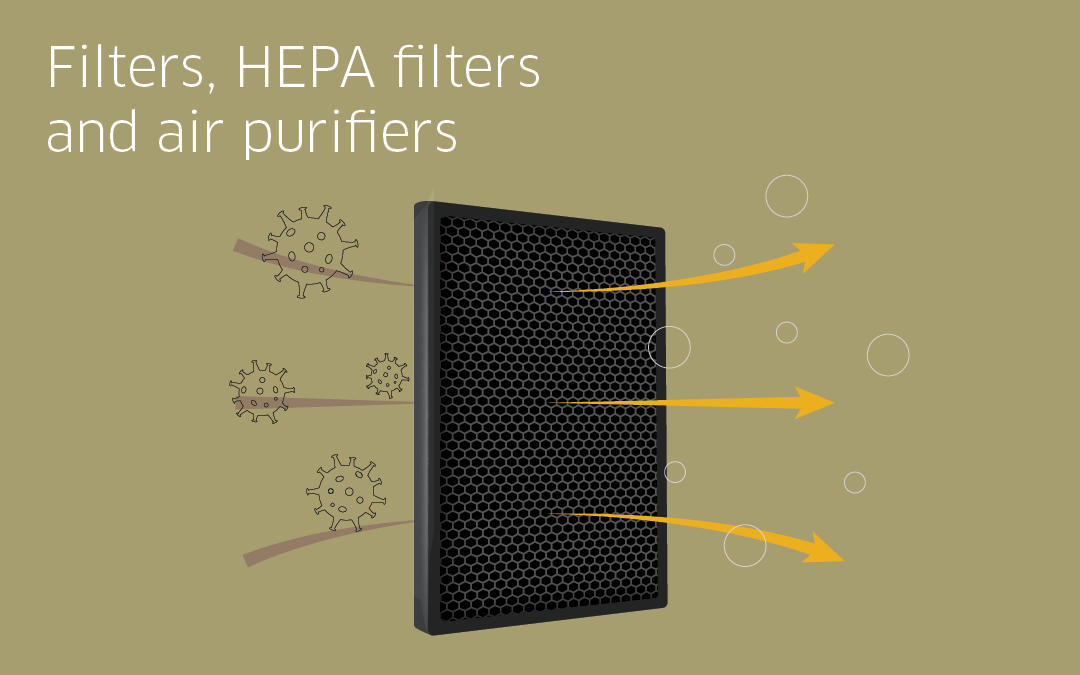
Filters, HEPA filters and air cleaners/purifiers
HEPA filters and portable air cleaners/purifiers have been subject to a lot of talk due to the need to boost ventilation from COVID-19 pandemic times. While HEPA filters and air cleaners/purifiers have their uses in specialist settings, standard filters can prove...
From the news archives…
Filters, HEPA filters and air cleaners/purifiers
HEPA filters and portable air cleaners/purifiers have been subject to a lot of talk due to the need to boost ventilation from COVID-19 pandemic times. While HEPA filters and air cleaners/purifiers have their uses in specialist settings, standard filters can prove...
VIDEO: air conditioning leaking water – 6 common causes
An air conditioning unit leaking water is one of the most common and sometimes the most disruptive building service problems – due to unit locations – in a workplace environment. Leaking air conditioning units generally occur over the summer months where their use and...
HVAC and water systems operation in COVID-19
Version 2 | updated: September 2021 Good ventilation – natural or mechanical – is one of the best ways of fighting coronavirus/COVID-19 and diluting virus particles that might be present in the workplace. This is a guidance document on currently known best practice...
VIDEO: planned preventative maintenance (PPM) – improve, reduce, save
Planned preventative maintenance (PPM) reduces the likelihood of heating, ventilation and air conditioning (HVAC) system failure, improves efficiency and saves you time and money. Well maintained HVAC systems are proven less likely to fail and cause interruption to...
VIDEO: frost or ice on coils or pipes in heat pumps and air conditioning systems
Heat pumps and air conditioning systems are integral parts of a building’s operation through the role they play for people and product development. Heat pumps are a cost effective and efficient way of providing heating, cooling (only in reversible systems) and hot...
Talk To Thermodial
When Thermodial were founded in 1986, the founders had a vision of an engineering focused service, but also one that was responsive and reliable.
This belief should hold true to dealing with questions or information requests, such as one you may have.
Please contact us by filling in the form below, for a prompt response; email info@thermodial.ie or ring us in Dublin.
As the experts in HVAC maintenance, upgrades and energy management, we would be happy to respond to your requests.
